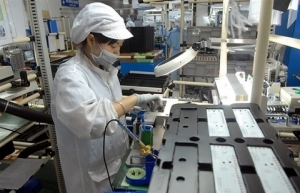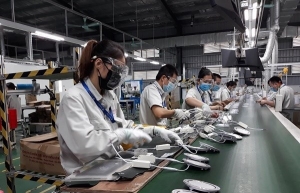Assisting local groups with aspiration to reach higher
The starting point of Giza is a facility and workshop developer for industrial zones. After nine years, the group has expanded operations to supporting industries. What is the story behind this transition?
 |
| Ngo Huu Tiep, chairman of Haast Industry Vietnam, a subsidiary of Giza E&C |
Many years ago, our close partner Eva Haiphong Precision Industries Co., Ltd., which is located in the northern city of Haiphong, suggested we jump into the industrial production sector to become their vendor. Eva’s director also said that they would support us to train engineers and a skilled labour force.
At the time, we had experience in workshop construction in collaboration with the partner’s supporting commitment. We also forecast that the opportunity in the long-term would be widened. Thus, we decided to establish Haast Industry Vietnam as the starting point for the roadmap to industrial production.
Since early 2021, the factory has operated smoothly and our portfolio of partners has expanded. We have also received much support from the Ministry of Industry and Trade, as well as through training courses organised by Samsung and Panasonic, among other factors.
Vietnam boasts big potential for industrial development. Do you think there will be a trend in the transition of enterprises into industrial production?
Investing in the supporting industry, especially in precious mechanics, is hard going and requires determination. This is because domestic enterprises have to cover the entire works, from ensuring input materials and product standards to offering competitive selling prices and looking for partners.
Domestic suppliers have to compete with foreign-invested vendors which enjoy massive incentives, including imported taxes on materials. In general, as satellite enterprises for large-scale groups, foreign-invested vendors have an available output for their products. Besides that, they are proactive in materials and receive massive support from parent companies.
Investing in this sector needs a large capital volume and it is a long-term investment, but some credit organisations and banks have yet to be interested in offering long-term loans with incentive lending rates. Meanwhile, foreign-invested suppliers enjoy a lending rate at an average of 2 per cent a year, while local manufacturers have to suffer a rate of over 10 per cent annually. Thus, they face woes in arranging capital for the mid- and long-term.
As a result, such a transition will not become a true trend anytime soon, and Haast is quite alone on this path.
How can an ecosystem be built for domestic supporting industries?
It is quite challenging because there is a problem that domestic enterprises just prefer choosing orders with simple requirements or available designs instead of spending time, capital, and brainpower deeply studying to create key products.
To improve the situation, enterprises need to have the aspiration and determination to participate in global supply. Besides that, the government should have more support policies, especially incentives relating to capital, for businesses which have aspirations and dare to face obstacles to make the supporting industry take off.
We see that many foreign experts in countries with developed industrial sectors want to look for career opportunities in developing countries such as Vietnam. They are a precious human resource to improve the domestic supporting industry. Meanwhile, many domestic enterprises are willing to hire foreign experts with high salaries and convenient accommodation. Thus, we hope that ministries and relevant authorities will be intermediate units to connect the two parties.
What are the opportunities for local suppliers once their capacity is standardised?
The government is doing a great job to promote Vietnam’s image overseas and encourage capital inflow. That community highly appreciates Vietnam’s investment environment and the capital inflow is improving this year.
During the process of working with foreign partners, although foreign-invested groups may have a group of satellites in Vietnam, they really have a demand for increasing the localisation ratio with the main purpose of avoiding dependence on vendors and to ensure on competitive selling prices between them. They encourage Vietnam to foster the development of the supporting industry and open more factories.
The barrier remains available, but once local manufacturers overcome challenges, opportunities arise. You can look back at China’s supporting industries 20 years ago. Chinese supporting industries’ starting point was similar to Vietnam’s situation now but it now boasts global supporting vendors such as Foxconn and Pegatron. Local manufacturers will establish room for themselves if they dare to be pioneers and pave the path ahead.
 | Hanoi to develop supporting industries The capital city of Hanoi has set up many solutions to develop other supporting industries, aiming to increase the municipal supporting industry development index. |
 | Industrial production recovers quickly with growth of 9.4 percent in eight months The index of industrial production (IIP) in the first eight months of 2022 surged 9.4 percent over the same period last year, according to the General Statistics Office (GSO). |
What the stars mean:
★ Poor ★ ★ Promising ★★★ Good ★★★★ Very good ★★★★★ Exceptional
Related Contents
Latest News
More News
- Kolon signs $48 million airbag supply deal with Autoliv (December 15, 2025 | 18:14)
- National Assembly approves Vinh–Thanh Thuy expressway project (December 15, 2025 | 18:02)
- Quang Tri green-lights $1.59 billion LNG-fired power project (December 15, 2025 | 17:59)
- Stress laid on high-quality FDI inflows (December 15, 2025 | 11:00)
- Can Tho utilises its growth advantages (December 15, 2025 | 09:09)
- Ca Mau unlocking potential to shape a more sustainable future (December 15, 2025 | 09:02)
- Major projects to be inaugurated nationwide (December 15, 2025 | 08:00)
- MoF workshop highlights mounting concerns over ODA on-lending costs (December 12, 2025 | 16:05)
- National Assembly approves pilot mechanisms to accelerate major projects in Hanoi (December 12, 2025 | 11:29)
- Legislation gives government flexibility for loan guarantees (December 11, 2025 | 18:04)

 Tag:
Tag:






















 Mobile Version
Mobile Version